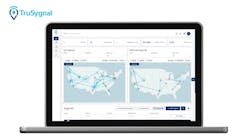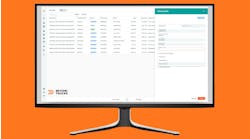A wide-ranging “virtual roundtable” recently hosted by technology provider Omnitracs addressed a broad swath of trucking issues from a Canadian perspective – especially in terms of how electronic logging devices (ELDs) are but one piece of the technology puzzle that can giving motor carriers more leverage in the freight business.
Moderated by Mike Ham, vice president and general manager of Omnitracs Canada, the roundtable included: Stephen Laskowski, incoming president of the Ontario Trucking Association (OTA); David Carruth, CEO of LTL carrier ONE for freight; and Tom Cuthbertson, vice president of regulatory compliance at Omnitracs.
OTA’s Laskowski said that the impending imposition of the ELD mandate in the U.S. on December 18, which he expects will be mirrored by a similar mandate for Canadian truckers by late 2019, is “bringing to head” inefficiencies within supply chain, particularly for drivers, who bear the brunt of them.
“What is beginning to happen now is that drivers, carriers, shippers, and 3PLs are having ‘real-world conversations’ about the cost of inefficiencies, their impact on drivers, and what it takes to remove them,” he said.
“They are all recognizing that the supply chain needs to be re-worked; loading and unloading inefficiencies need to be eliminated because they no longer can be absorbed by drivers,” Laskowski pointed out.
He believes ELDs are going to make “things more transparent” in trucking and eventually let drivers do what they do best – “that’s drive trucks” – while letting shipper and carrier management make decisions on shared and more accurate information.
“It’s about building relationships, creating value, and getting paid for it,” noted ONE for freight’s Carruth. “Without data, we can’t go to anyone and say ‘this would be better.’ Without information can’t say what works great or what needs to get better. We need use information to avoid being a commodity.”
Omnitracs’ Ham said that is leading to “different conversations with shippers today than in the past,” ones based on accountability.
“Technology provides information that help the driver do his or her job while establishing shipper expectations,” he explained. “I can’t emphasize how drivers appreciate that accountability; it allows them to focus on driving and safety.”
But that’s not the only technology avenue that is providing truckers with more leverage in cargo-hauling discussions, noted One for freight’s Carruth.
“We are building artificial intelligence into our TMS [transportation management system] so it can be more predictive and help us make better decisions,” he explained, such as mapping out better routes that avoid traffic jams and slow downs.
“It’s about using technology to eliminate stupid. When I bought this business 20 years ago, we had no technology at all. Now we’re driving headlong into technology,” he stressed.
Data is also helping ONE for freight drive more profitability for itself and independent contractors, too, Carruth added.
“Half my fleet is made up of company drivers and half owner-operators,” he said. “We’ve taken fuel mileage data and compared two of our owner-operators driving 25,000 miles in the same region. One achieved 8.64 mpg and other 5.4 mpg; that is a difference of $24,000 a year going into their pocket.”
Omnitracs’ Cuthbertson noted that the top technology insurance companies are looking closely at is video recording. “There is no vagueness with it,” he stressed. “It points directly to situations that many times in most cases benefits of the carrier.”
ONE for freight’s Carruth added that when he approached his drivers about whether or not to install forward facing video cameras, they instead desired “three-way” camera systems to monitor the front and both sides of their trucks to record everything going on all around them.
“Technology brings awareness to all our drivers,” he emphasized. “All of our equipment now ordered with the most advanced collision mitigation technology available. It tells our drivers what is going on around them.”
Omnitracs’ Cuthbertson also stressed that fleet executives should not approach such technology – from ELDs to video systems – with a “narrow, financial side” return on investment (ROI) calculation in mind.
“Hard numbers do not do justice to technology,” he said. “Technology links drivers, shippers, and dispatchers into tighter and more dynamic interactions all day long. Take dealing with consignee delays; raw [time] data is not vague – [ELDS record] how long the delay actually was.”
Using technology in this manner makes things better for carriers and will boil down to dollars and cents saved once they get through the installation, training, and adjustment to technology, he said.
“Those kinds of things hit big,” Cuthbertson noted. “It may not come in first three months, but carriers will see them, absolutely.”



